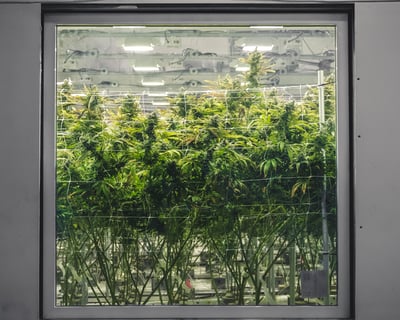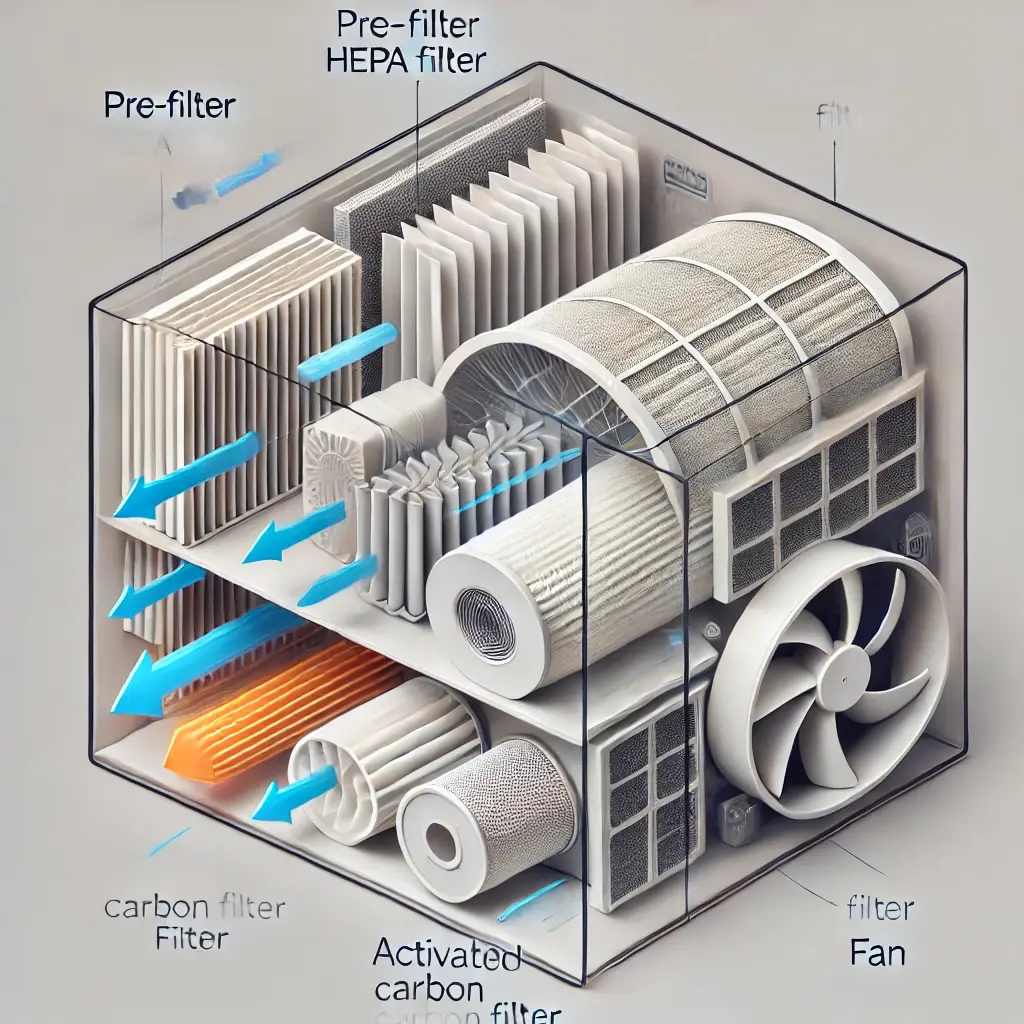 Hey there, fellow plant enthusiasts! If you're growing marijuana, you probably already know that creating just the right environment for your green buddies makes all the difference in what you harvest at the end of the day. They need the right temps, proper humidity levels, and good airflow to stay happy and healthy. And let's not forget about fresh air - without a decent supply of CO2, photosynthesis just won't happen! If you've been at this for a while, I bet you've got a pretty solid grow room ventilation system pumping outside air in to keep your plants thriving. Those Spider Farmer inline fans are real workhorses for any decent ventilation setup. And those active intake systems (the ones with fans pulling air inside) work hand-in-hand with your exhaust fan to keep that air moving nicely.
Hey there, fellow plant enthusiasts! If you're growing marijuana, you probably already know that creating just the right environment for your green buddies makes all the difference in what you harvest at the end of the day. They need the right temps, proper humidity levels, and good airflow to stay happy and healthy. And let's not forget about fresh air - without a decent supply of CO2, photosynthesis just won't happen! If you've been at this for a while, I bet you've got a pretty solid grow room ventilation system pumping outside air in to keep your plants thriving. Those Spider Farmer inline fans are real workhorses for any decent ventilation setup. And those active intake systems (the ones with fans pulling air inside) work hand-in-hand with your exhaust fan to keep that air moving nicely.
But here's the thing - ventilation alone can sometimes create its own headaches. All that "fresh air" might be bringing unwanted guests like toxins and airborne nasties into your grow room that could give your plants a hard time. Alongside your ventilation, you really want to consider a good purification and filtration system to make sure the air quality stays top-notch. Carbon filters are absolute gold for getting rid of those odors and cleaning up the air. They'll affect how efficiently your air circulates though, so you might need to tweak your airflow calculations a bit. Without these extra steps, all that work you're doing to control temperature and humidity won't get you very far.
If your grow room ventilation setup doesn't have air quality and purification covered yet, here are some of the troublemakers that might be bothering your marijuana plants.
Understanding Grow Room Ventilation
Grow room ventilation is really the foundation of successful indoor growing. It's worth knowing that cannabis seeds are super important in how cannabis plants develop - they're where everything starts for healthy growth. Good ventilation plays a huge role in keeping temperature and humidity just right, which your cannabis plants absolutely need to thrive. A well-designed system helps get rid of extra heat and moisture while making sure your plants get plenty of fresh air. This isn't just good for photosynthesis - it also stops mold and mildew from setting up shop in those still, humid spots that they love so much.
When you're putting together your indoor grow, picking the right ventilation system for your space size and what your plants need is key. Look for systems where you can adjust the airflow and that have quality fans and ducting. This lets you fine-tune things to help your plants grow their best and give you the biggest yields. Remember, a good ventilation system isn't just a fan stuck in the wall - it's an investment in how well your indoor garden will do overall.
What is Grow Room Ventilation?
In simple terms, grow room ventilation is all about moving air in and out of your growing space to keep temperature, humidity, and CO2 levels just right for your plants. A good system is absolutely essential for indoor growing - it helps remove excess heat, manages humidity, and keeps pests and diseases at bay. Proper airflow ensures your cannabis plants get all the fresh air they need to really thrive. By constantly bringing fresh air in and pushing stale air out, a solid ventilation system supports the overall health of your plants, which is really the cornerstone of successful indoor growing.
The Importance of Air Circulation
Air circulation is super important for keeping your indoor grow environment healthy. Good circulation helps spread heat and humidity evenly throughout your space, which prevents hot spots and reduces the chances of getting mold and mildew. It also helps strengthen your cannabis plants' stems, making them tougher and better able to support bigger buds.
In an indoor grow room, you get good air circulation through a combination of fans, ducting, and filters. Those oscillating fans are particularly handy for moving air around the room, making sure every part of the plant gets fresh air. Inline fans and ducting systems work together to pull stale air out and bring fresh air in. When you keep that air flowing steadily, you create an environment where plants can grow their best while minimizing the risk of pests and diseases.
Benefits of Good Air Circulation
Let me tell you, good air circulation is absolutely vital for healthy plant growth. It prevents heat and humidity from building up in your grow room, which can lead to smaller yields and more problems with pests and diseases. When air circulation is working well, every part of your plant gets the CO2 it needs for photosynthesis, which encourages strong, healthy growth. Plus, by preventing pockets of stagnant air, good circulation cuts down the chances of mold and mildew, creating a more resilient growing environment. This doesn't just help your plants stand strong - it also helps them produce better quality buds.
Choosing the Right Exhaust System
Picking the right exhaust system is crucial for maintaining ideal conditions in your indoor grow room. A good exhaust system helps remove excess heat and moisture, which can otherwise become a breeding ground for mold and pests. It also ensures your cannabis plants get a steady supply of fresh air, which they absolutely need for photosynthesis and overall health.
When shopping for an exhaust system, think about the size of your grow room and what your plants specifically need. Bigger spaces need more powerful exhaust systems to ensure adequate air exchange. Look for systems with high-quality fans, ducting, and filters. These components work together to provide efficient air circulation, helping maintain ideal temperature and humidity for healthy plant growth. Investing in a good exhaust system is really one of the key steps toward a successful indoor grow.
Determining the Volume of Your Space
To figure out the volume of your grow space, you'll need to measure the length, width, and height of the room and multiply them together. This gives you the total volume in cubic feet. Once you know that number, you can determine what CFM (cubic feet per minute) rating you need for your fan. A handy rule of thumb is to exhaust the volume of your space at least once every minute. For example, if your grow room measures 10 feet long by 10 feet wide by 8 feet high, you've got 800 cubic feet of space. So you'd want a fan with at least an 800 CFM rating to keep things properly ventilated.
Exhaust Efficiency and Fan Speed
Exhaust efficiency is really about how well your ventilation system can remove heat and moisture from the grow room. Fan speed plays a big part in this, as it determines how quickly air gets exchanged. Higher fan speeds can improve efficiency, but they'll also boost your energy bills. It's important to find that sweet spot between fan speed and energy efficiency to keep your plants growing well. By adjusting fan speed to match what your specific grow space needs, you can make sure your ventilation system runs efficiently, providing a stable environment where your cannabis plants can really flourish.
Managing Excess Heat and Humidity
Excess heat and humidity are common challenges when growing indoors, and they can really take a toll on your cannabis plants. High temperatures stress plants out, which often leads to smaller yields and lower quality buds. Too much humidity creates the perfect conditions for mold and mildew to thrive, which puts your whole crop at risk.
A well-designed ventilation system is essential for managing these conditions. Using a combination of fans, ducting, and filters helps remove excess heat and moisture from your grow room. This maintains a stable environment where your plants can thrive. If you're growing in a particularly hot or humid climate, you might want to consider using air conditioning or dehumidifiers too. These tools give you extra control over your grow room conditions, helping ensure your plants stay healthy and productive.
The Role of Carbon Filters in Ventilation
Carbon filters are absolutely essential for any indoor grow room ventilation system. They work by trapping unwanted odors, molds, spores, dust, pollen, and other harmful particles, keeping your grow space clean and healthy. This is especially important indoors, where poor air quality can quickly lead to pest problems and plant diseases.
When shopping for carbon filters, look for high-quality options specifically designed for indoor growing. These filters are better at catching contaminants and can really improve the air quality in your grow room. By adding carbon filters to your ventilation system, you create an environment that supports optimal plant growth while reducing pest and disease risks. This not only protects your investment but also ensures your cannabis plants produce the best possible yields.
Active Intake and Exhaust Systems
Active intake and exhaust systems are designed to provide balanced airflow in your grow room. An active intake system uses a fan to pull fresh air in from outside, while an active exhaust system uses a fan to push stale air out. This type of setup works great for large-scale commercial grows because it provides consistent and controlled airflow. You can customize active intake and exhaust systems to fit specific grow room sizes and setups, and they work well with other grow room equipment like LED grow lights and irrigation systems. By ensuring steady air exchange, these systems help maintain optimal temperature and humidity levels, supporting the overall health and productivity of your cannabis plants.
Bacteria and Ventilation System
Did you know plants can catch bacterial infections just like we do? The tricky part is they're harder to spot in plants because the signs look so similar to other plant problems. For instance, those spotted and dying leaves could be bacteria at work - or something else entirely. The good news is you won't have to play plant detective if you use proper air filtration with your grow room ventilation. A good filter is like having a bouncer at the door, keeping those microscopic troublemakers from crashing your grow party.
Insects
Think growing indoors means no bug problems? Well, if your ventilation system doesn't have a way to keep the critters out, you might be in for a surprise!
Indoor plants are particularly vulnerable to those tiny spider mites that hitch a ride on the breeze and can easily sneak in through your ventilation if you don't have a good filter. Once they're inside your grow room, these little pests start munching on your marijuana leaves, then spin webs and lay eggs all over your plants. Because they're so small and stubborn (like that one relative who won't leave after the party's over), an infestation is really tough to clear up before they damage your crop.
Molds and Fungi in Indoor Growing
If there's one thing that should keep you up at night as an indoor grower, it's airborne mold and fungi spores. These guys absolutely love moist, humid environments with plenty of organic matter - basically, your grow room is their dream home! Once they settle in on your plants, it doesn't take long for them to cause rotting diseases that can wipe out your crop.
There are tons of molds and fungi that can invade your grow room if you're not careful: black spot, botrytis, powdery mildew, Fusarium... the list goes on. Using proper air purification equipment with your ventilation system is like putting up a "No Vacancy" sign that stops all these unwanted guests before they can check in.
Pollen and Temperature and Humidity Levels
If you've ever suffered through seasonal allergies, you know how easily pollen floats through the air. While this isn't the biggest worry for marijuana growers, it's good to know that invasive pollen can cross-pollinate with your plants and affect your product. This is especially important if you enjoy breeding new plants - unintended pollination can throw a wrench in the results you were hoping for, kind of like adding salt instead of sugar to your coffee!
Volatile Organic Compounds and Carbon Filter
Volatile organic compounds, or VOCs, are basically chemical compounds in gas form. Those harsh chemicals like fungicides and insecticides can be real troublemakers for plant life. At the very least, you don't want your marijuana plants soaking up chemicals that might affect the quality and safety of your product - nobody wants to smoke pesticides!
There are lots of factors to consider when setting up a marijuana grow room, and general air quality should definitely be on your list. Good ventilation alone just isn't enough. Think of it this way - you wouldn't drink unfiltered water from a questionable source, would you? Well, your plants deserve the same consideration! An air filter or similar purification method should be part of your grow room ventilation setup, just like you'd use a water filter to make water safer to drink.
Looking for more tips on creating the perfect environment for growing marijuana? Check out Pure n Natural's Grow Room Set Up Download right here. It's got tons of practical advice based on real-world experience!



.png)


